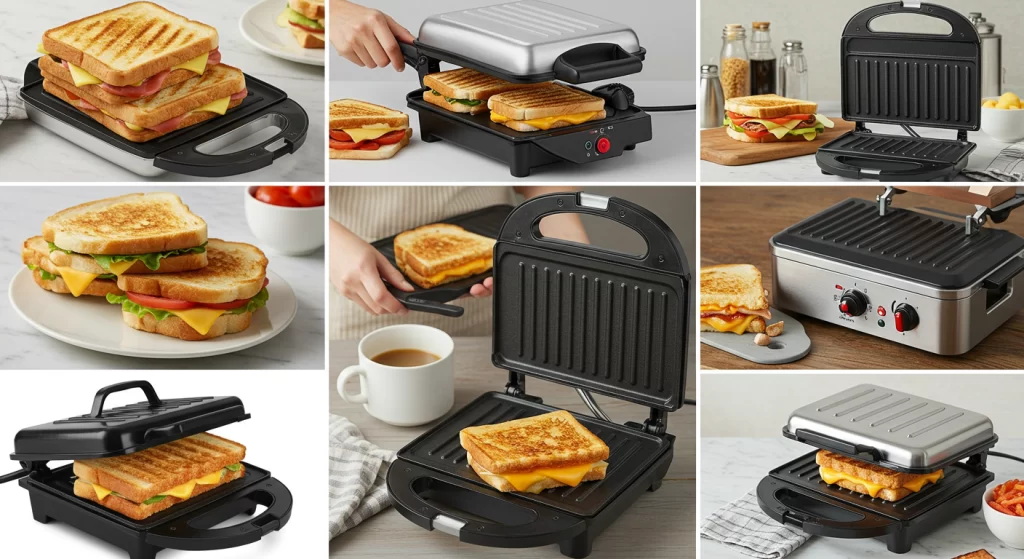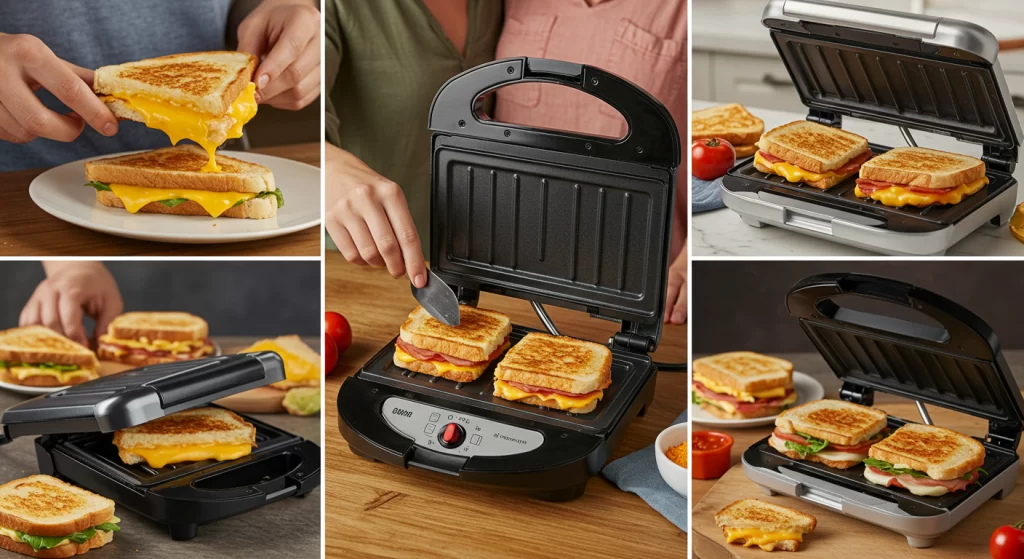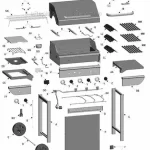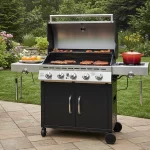There’s something magical about biting into a perfectly grilled cheese sandwich—that satisfying crunch giving way to gooey, melted cheese that stretches with each bite. While the humble stovetop method has served us well for generations, dedicated grilled cheese makers are changing the game. But are they worth the counter space? Let’s dive into everything you need to know about these specialized kitchen gadgets.
What Is a Grilled Cheese Maker?
A grilled cheese maker is a specialized kitchen appliance designed specifically for creating perfect grilled cheese sandwiches. Unlike traditional methods that require flipping and monitoring, these devices cook both sides of your sandwich simultaneously, applying consistent heat and pressure to achieve that golden-brown exterior and perfectly melted interior.
These nifty gadgets come in several varieties:
- Dedicated sandwich makers: Specifically designed with plates shaped to seal the edges of your sandwich
- Panini presses: More versatile with flat or ridged plates that can be used for grilled cheese and other pressed sandwiches.
- Dual-purpose toasters: Some models can function as both toasters and sandwich makers

What Is the Best Grilled Cheese Sandwich Maker?
When looking for the perfect grilled cheese maker, several factors come into play:
Top Features to Consider
- Cooking Surface: Non-stick surfaces make cleanup a breeze and ensure your sandwich doesn’t become a sticky mess.
- Temperature Control: Models with adjustable heat settings give you precise control over how quickly your sandwich cooks.
- Size: Consider how many sandwiches you typically make at once. Some models can make two or even four sandwiches simultaneously.
- Versatility: Some sandwich makers can also grill meats, press paninis, or make waffles with interchangeable plates.
While I won’t endorse specific brands, the best grilled cheese makers tend to have reliable heating elements, durable construction, and easy-to-clean surfaces. Look for models with good user reviews that highlight consistent results and longevity.
The Difference Between Grilled Sandwich Makers and Other Kitchen Appliances
Grilled Sandwich Maker vs. Panini Maker
While they might look similar, there are key differences:

Sandwich Maker vs. Toaster
Many people wonder if they can just use their toaster instead:
- Toasters heat bread from the sides, but don’t apply pressure
- Sandwich makers cook both bread and fillings simultaneously
- Some hybrid models can do both jobs
- A toaster requires you to assemble your sandwich after toasting

How Long to Cook Grilled Cheese in a Sandwich Maker?
The perfect timing depends on several factors:
- Most grilled cheese sandwiches cook in 3-5 minutes in a dedicated maker
- Thicker bread or more cheese might require 5-7 minutes
- Preheating your sandwich maker (typically 2-3 minutes) ensures even cooking
- Watch for the indicator light on your device, which often signals when your sandwich is ready
I’ve found that the sweet spot is usually around 4 minutes for a standard sandwich with medium-slice bread and average cheese thickness. But don’t be afraid to experiment—your perfect timing might differ based on your preferences for crispiness.
The Secret to a Good Grilled Cheese Sandwich
Whether you’re using a dedicated maker or not, certain principles elevate your grilled cheese game:
Bread Selection Matters
What bread works best? The debate rages on, but these are top contenders:
- Sourdough: Offers tangy flavor and structural integrity
- White bread: Classic choice that crisps nicely
- Brioche: Adds richness and a touch of sweetness
- Rye: Provides a distinctive flavor that pairs well with stronger cheeses
Cheese Choices Make a Difference
The quintessential grilled cheese experience depends heavily on your cheese selection:
- American cheese: Melts perfectly and delivers that nostalgic flavor
- Cheddar: Sharp flavor, but can separate if overheated
- Gruyère: Exceptional melting properties with nutty flavor
- Monterey Jack: Mild and melts beautifully
- Fontina: Italian cheese with exceptional stretch and creaminess
Pro tip: Grate or thinly slice your cheese for faster, more even melting.
The Butter vs. Mayo Debate
Does grilled cheese taste better with mayo or butter? This culinary controversy has passionate advocates on both sides:
- Butter: Provides rich flavor and helps achieve golden browning
- Mayonnaise: Spreads more easily when cold and creates an incredibly crispy exterior
Why does mayo work better for grilled cheese? Its higher smoke point and spreadability at cold temperatures give it an edge for many home cooks. I use both—mayo on the outside for crispiness and a thin layer of butter on the inside for flavor.

Professional Tips for the Perfect Grilled Cheese
What would Gordon Ramsay put in his grilled cheese? While the famous chef has his take, professional sandwich makers often recommend:
- Using room-temperature butter for easier spreading
- Adding thin slices of complementary ingredients like tomato or ham
- Letting your cheese come to room temperature before cooking
- Pressing gently during cooking for optimal contact with the heating surfaces
How to Get a Good Cheese Pull
Those Instagram-worthy cheese pulls don’t happen by accident:
- Use a combination of cheeses, including at least one high-melt variety (mozzarella, Gruyère, or fontina)
- Don’t overcook—you want the cheese melted but not completely broken down
- Let your sandwich rest for 30 seconds after cooking before cutting
- Cut diagonally for maximum stretch potential when pulling apart
How Many Slices of Cheese Should You Use?
The ideal amount depends on bread size and thickness, but generally:
- For standard sandwich bread: 2-3 slices or about 1/4 cup shredded
- For larger artisanal bread: 3-4 slices or about 1/3 cup shredded
- Always ensure cheese reaches the edges for that perfect melt
Using Your Grilled Cheese Maker for Other Foods
Can a sandwich maker be used as a grill? Absolutely! Most grilled cheese makers are more versatile than their name suggests:
- Breakfast options: French toast, egg sandwiches, or hash browns
- Desserts: Stuffed French toast, fruit turnovers, or cookie sandwiches
- Other meals: Quesadillas, reheating pizza, or pressed vegetables
How can you make grilled cheese without a sandwich maker? If you don’t have a dedicated appliance, you can still achieve great results with:
- A skillet with a weight or a second pan on top
- A waffle iron (yes, really!)
- A regular toaster (toast bread first, then assemble)
Caring for Your Grilled Cheese Maker
To keep your sandwich maker in top condition:
- Allow it to cool completely before cleaning
- Wipe non-stick surfaces with a damp cloth—never use abrasive cleaners
- For stuck-on cheese, use a soft brush or plastic scraper
- Store with plates slightly open to prevent damage to hinges or non-stick coatings
Conclusion: Is a Grilled Cheese Maker Worth It?
Whether a dedicated grilled cheese maker deserves space in your kitchen depends on your sandwich habits. The convenience and consistent results make it worthwhile if you regularly enjoy grilled cheese or pressed sandwiches. For occasional enjoyment, traditional methods might suffice.
What makes these devices so appealing is their simplicity—they transform a good sandwich into a great one with minimal effort. They create that perfect balance of crispy exterior and molten interior that’s hard to achieve consistently on a stovetop.
What’s your favorite grilled cheese combination? Do you prefer a dedicated sandwich maker or another method? Share your thoughts in the comments below!


